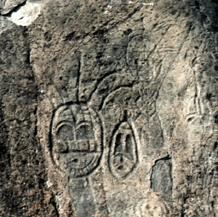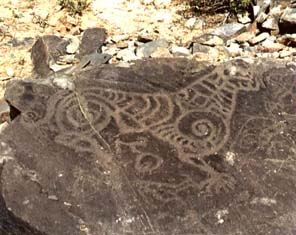Rock painting is the general term
including colored drawing, line carving and relief sculpture on the wall of
caves, cliffs or isolated rocks. People have used rocks as working tools and
articles for everyday use, even since remote antiquity. Meanwhile, rock is the
earliest painting material. Ancient people carved and drew on rocks to describe
their life, their dream and wish. That is Rock Painting. Various designs and
pictures of Rock Painting formed the earliest document of human beings before
the invention of character. Involving information of primitive residents'
economy, society and life, Rock Painting attracts people by its high artistic
value as the production of human mentality.
All over the world, Rock Painting was
found in many places. China is
the earliest country that found and recorded Rock Painting. Hanfeizi,
written in Warring States Period (475-221 BC) of China, records many examples related to Rock
Painting. Commentary on the Waterways, written by Li Daoyuan of Northern
Wei Dynasty (386-534), also has many records on it. Wide in distribution and
large in number, China became an
important component of world's Rock Painting. According to its area, content and
style, Chinese rock painting falls into three schools -- the northeast, the
southwest, and the southeast. Most northern Chinese Rock Paintings are found in
the Inner Mongolia Autonomous Region, Xinjiang Uygur Autonomous Region, Ningxia
Hui Autonomous Region and Qinghai Province of West China. Their techniques are
mainly grinding and carving, in a realistic style. Rock Paintings of southwest
school are often found in Yunan
Province, mainly representing
religious activities and painted in red. As to Rock Paintings found in coastal
area of southeast China, most
are about sailing and represented in abstract designs by chiseling and
carving.
Most Rock Paintings found in ethnic
areas of China are works of
ethnic artists. It was recorded in ancient documents that in Chinese northern
pastures once lived some minorities like Eastern
Hu, Hun, Turks, Qidan, Nuzhen, Mongol, and so on.
However, there are only relics of Rock Paintings left, scattered among cliffs
and wild grass.
Rock Painting is the history record written
on cliffs and rocks. Books of most dynasties in China only recorded lives of emperors, seldom
mentioned people's daily life. However, what we see in Rock Paintings are: about
production like hunting, grazing animals, agriculture, and so on; about religion
like worshipping ancestors, sacrificial rites, and so on; and about daily life
like villages and dancing. Rock Painting about daily life is of great
importance. Human-face Rock Paintings are found everywhere in the world. Those
found in China is of large
number and various styles, and gain prominent status in world's Human-face Rock
Painting. Both in the inland and remote areas numerous artistic works of this
type were found. Human-face Rock Paintings shed light on ancient people's
religious consciousness. Those peculiar designs represent a mental world that we
know little. Rock Paintings in every part of China contain some abstract symbols composed
by geometric figures, expressing certain ideas in the abstract way or recording
certain events. Among those symbols, some are easy to understand, for instance,
the symbol of the sun, the handprint and the footprint. Those Rock Paintings
bring us to the remote ancient time and abridge the long time of
history.



